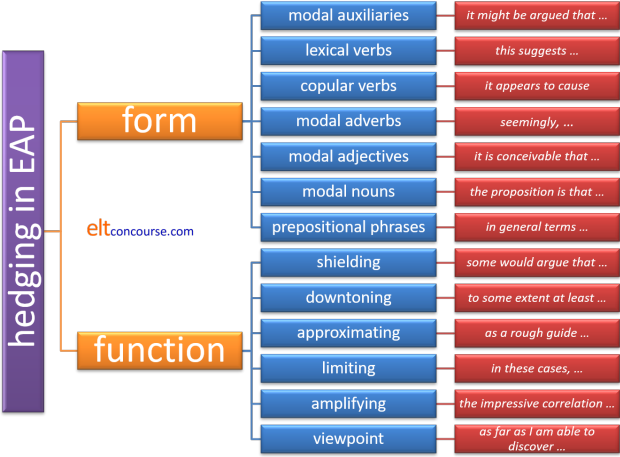Hedging and modality in EAP

To get an idea of the importance of this area, compare:
- It is clear that Guru is right when he states ... and we must act on his proposal by ...
- It is probably arguable that Guru may well be right when he states ... and it may be advisable to act on his proposal by ...
Sentence 1. invites the reader try to imagine
all the times when Guru is wrong and also to reject the obligation
to do anything at all.
Sentence 2., on the other hand, is appropriately hedged with
modality, expressing doubt rather than certainty and possibility
rather than obligation. It sounds reasoned and tentative
rather than trenchant and intransigent.
Getting this right is not something that comes easily to writers operating in their first languages and in an additional language is even more difficult so the area needs attention. The failure to modulate assertion appropriately is common especially for inexperienced or non-native writers.
 |
How to hedge |
The term hedging is somewhat disparaging, implying
wishy-washiness and the inability to be decisive. Consider
this example from the once-popular British TV series, Yes
Minister. It is the response of a civil servant to the
Minister's simple question
... are
you going to support my view that the Civil Service is over manned
and feather-bedded, or not? Yes or no? Straight answer.
 |
Well Minister, if you asked me for a straight answer,
then I shall say that, as far as we can see, looking at it
by and large, and taking one time with another, in terms of
averages of departments, then, in the final analysis, it is
probably true to say that, at the end of the day, in general
terms, you would probably find that, not to put too fine a
point on it, there probably wasn't very much in it one way
or the other, as far as one can see, at this stage. |
This is, of course, an extreme example, designed for comic effect
but it is also clear that a response such as
No, Minister.
would not have been appropriate, given the fuzziness of the data and
the speaker's wish to be uncommitted.
Hedging of that sort is not appropriate but hedging in academic writing is very frequent and very frequently not satisfactorily achieved either by inexperienced writers in their first language or those struggling to write in academic style in a second language.
In this guide, the focus is on hedging in the statement of a proposition, but the choice of reporting verb, in the case of comment on another's work is also important. For more on how the choice of reporting verb affects the communicated attitude of the writer, see the guide to reporting verbs in EAP.
 |
Ways to hedge |
There are a number of ways to classify hedging in academic writing (and arrange a teaching programme). We'll look at two here, one focused on function and one on form, which seem the most useful for our purposes. For more data on vague language, try the excellent book by Channell (1994).
 |
Focus on function |
The following is drawn from Jordan (1997) who follows Salager-Meyer (1994).
- Shields:

These terms express degrees of certainty or possibility and include a range of pure and marginal modal auxiliary verbs as well as adverbials used to soften the a proposition, i.e., to shield the writer from accusation of too much assertion. Examples will be enough here but see below under form for more analysis.- Pure modal auxiliary verbs:
The discrepancy could be the result of ...
It might be argued that ...
It does not have to be the case that ...
It may be argued that ...
Some would argue that ... - Marginal modal auxiliary verbs:
It seems to be the case that ...
This tends to be the result of ...
It is likely to be caused by ... - Adverbials:
This results, quite possibly, in ...
It seems arguably possible that ...
Conceivably, ...
Presumably, ...
- Pure modal auxiliary verbs:
- Downtoning, approximating and (less frequently) intensifying:

These terms are usually adverbials, often just adverbs. They generally modify adjectives or other adverbs. For example:- Downtoners:
The is slightly different from arguing that ...
This is marginally different from ...
This results, to some extent at least, show ... - Approximators:
This is approximately the same number of ...
Roughly, the data can be divided into three sections - Intensifiers:
It is particularly noteworthy that ...
There are impressively close parallels between ...
- Downtoners:
- Expressions which imply the author's personal viewpoint.

For example:
As far as I am able to discover ...
We have no direct knowledge of ...
We are unaware of any contrary findings in the literature.
A now famous example in the literature is this one concerning the discovery of the structure of DNA:
It has not escaped our notice that the specific pairing we have postulated immediately suggests a possible copying mechanism for the genetic material.
(Watson and Crick, 1953, p738)
They could of course have said, It is obvious that ... and we have won a Nobel Prize but that is not the way it's done. - Compounding the hedges. It is possible to heighten the
hedging effect by combining any of the above. For example:
It may, quite arguably, be the case that ...
It seems, as far as we can discover, to be the result of ...
 |
Focus on form |
An alternative way to classify how we hedge is to look at which forms we use rather than the (many) functions they perform.
- Modal auxiliary verbs:
As we saw above, of the pure modal auxiliary verbs, could, may, might, would are common hedges and, in the negative only, don't/doesn't have to is usable. The three marginal modal auxiliary verbs exemplified above also play a role. The modal would is often used to distance the writer. Compare, for example:
We argue that ... vs. We would argue that ...
Modal auxiliary verbs not used in this way, or in academic writing generally, include should, must, ought to and, in the negative couldn't and can't (have). These make the writer seem overly assertive and are avoided. For example:
This must / can't / couldn't be be the result of ...
We should focus on ...
It ought to be clear that ... - Lexical verbs:
These are often copular verbs standing in place of the too-assertive, be. Compare, e.g.:
This is the result of ... vs. This appears to be the result of ...
The outcome is that ... vs. The outcome appears to be that ...
Other verbal processes are also common. For example:
This suggests (i.e., I suggest)
This leads to the conclusion ... (i.e., I conclude)
In general, the present-simple use of the verb be sounds overly assertive in many cases. - Modal adverbials. See above for other examples.
Here are some more:
It is apparently the case that ...
Seemingly, the respondents have taken the view that ...
Ostensibly, this is a reason for concern
Outwardly, the materials are ...
etc. - Modal adjectives, often used predicatively after a complex
nominalisation. For example:
A probable outcome is ....
A new and more complex model of the phenomena is possible
One quite likely outcome is ...
More serious and longer-lasting consequences are imaginable
It is conceivable that ...
The results so far are promising
etc. - Modal nouns formed from these adjectives are an alternative.
For example:
One possibility is that ...
A reasonable assumption might be that ...
Our hypothesis is that ...
A postulation we can put forward is that ...
One proposition is ... - Prepositional phrases, acting often as adverbials, can also be
used to soften the assertive nature of a proposition. For
example:
This is, as far as we can see, ...
By and large, the process can be described as ...
If one looks in terms of averages ...
At this stage, it is difficult to predict ...
In general terms, ...
Summary (with a few examples)

 |
Teaching and learning issues in EAP |
As with much else in English for Academic Purposes, the situation
is complicated and the range of hedging terms is too great to
present easily. A piecemeal approach over a series of lessons
using elements of the analysis above is advisable.
You can take a function-to-form approach or a form-to-function
approach but:
- A function-to-form approach works best if you are focused on getting learners to produce suitably hedged expressions because they know (or should) what exactly it is that they want to express and need you to provide appropriate realisations of the functions.
- A form-to-function approach works best if you are focused on enabling learners to unpack the hidden messages in what they read because the forms are easy enough to spot (if you have primed their noticing) and then they can focus on what the author's intention is.
- Identification, noticing in other
words, often precedes any productive activity. An example
might be to get learners to note the differences between these
two paragraphs and speculate together (with you if need be) on
the reasons for the differences and the writer's choices.
Paragraph A Paragraph B It is obvious to all of us that the excessive use of private cars in cities is damaging to everyone's health and must be curbed. The best way of doing this is to charge drivers for the luxury of using inner-city roads, especially at peak times. The experience of London should be considered because that was clearly successful and must be emulated by other cities which clearly have the same problems. Many would argue that what some see as the excessive use of private cars in cities is possibly damaging to health and might usefully be curbed. A proposed way of doing this is to charge drivers for using inner-city roads, especially at peak times. The experience of London might be considered because that was arguably successful and could be emulated by other cities which may have the same problems. - Another noticing / awareness raising
procedure is to present learners with a range of possible ways
to express a thought and get them to rank them in terms of their
assertiveness. They then need to identify the language use
which led them to their conclusions. For example:
Rank the following from most to least assertive (A to F):
- cars obviously can sometimes create what some see as harmful pollution
- it is often asserted that cars create harmful pollution
- it is often asserted that cars may create harmful pollution
- it is often asserted that cars create harmful pollution in most circumstances
- it is often asserted that cars create harmful pollution in some circumstances
- cars are polluting monsters which should be banned forthwith
- Learners can also be presented with
very assertive statements and asked to make them more tentative
or vice versa. For example:
Fill in the gaps in this table:
Tentative Assertive It is conceivable that the material might be robust enough. → The material is obviously extremely robust. → I am convinced that this is the only possible solution. A possible analysis is that some commentators have tended to see this approach as being perhaps too harsh → → We must not accept these figures at face value. - A reasonable approach to the area is
to focus on one function and one or two forms (or realisations
of the functions) at a time. This will depend greatly on
the level of the learners.
- At lower levels, simple adverbs,
lexical verbs and modal auxiliary verbs are approachable:
might instead of must
arguably instead of clearly, obviously or certainly
I suggest rather than I think
etc. - At higher levels subtler
graduations of sense can be introduced:
At this stage we can be reasonably confident that ... instead of Now we know
It seems possible to conclude, at least for now, that ... rather than Obviously, ...
etc. - A possible ordering of a mini-syllabus
in the area is:
By function By form shielding pure modal auxiliary verbs
marginal modal auxiliary verbs
adverbialsdowntoning adverbials
prepositional phrases
modal adjectives
modal nouns from adjectivesapproximating adverbials
prepositional phrasesintensifying adverbs modifying adjectives viewpoint expression use of first person
alternatives to be, think, conclude etc.combining the above combining the above
- At lower levels, simple adverbs,
lexical verbs and modal auxiliary verbs are approachable:
- Learners can, if procedures such as these are followed, be persuaded to return to and edit their own texts or to deploy a range of hedging devices in what they write.
| Related guides: | |
| in-service skills index | for more on skills work |
| index | the EAP index |
| modality index | for a range of choices of where to go next and what to consider |
References:
Channell, J, 1994, Vague Language, Oxford: Oxford
University Press
Jordan, R. R, 1997, English for Academic Purposes,
Cambridge: Cambridge University Press
Watson, J. F and Crick, F. H. C, 1953, A Structure for
Deoxyribose Nucleic Acid, Nature 171: 737-738 available online
at: http://www.nature.com/nature/dna50/watsoncrick.pdf
